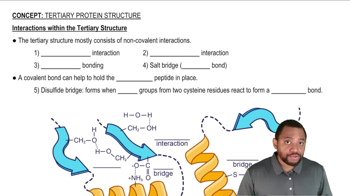Myoglobin is a protein containing 153 amino acids. Approximately half of the amino acids in myoglobin have polar side chains.
b. Where would you expect the nonpolar side chains to be?
 Verified step by step guidance
Verified step by step guidance



 2:7m
2:7mMaster Tertiary Protein Structure Concept 1 with a bite sized video explanation from Jules
Start learning